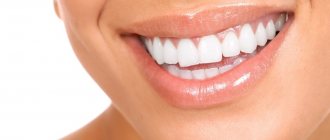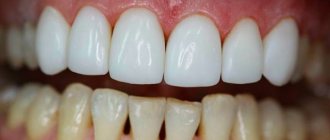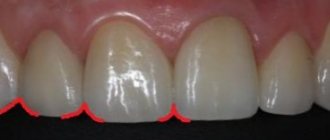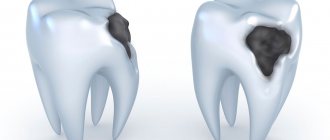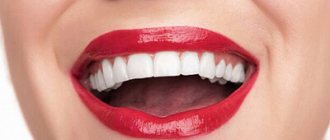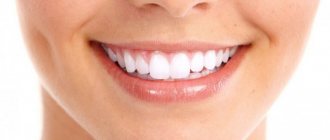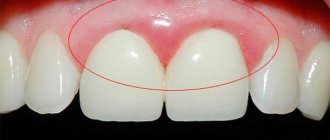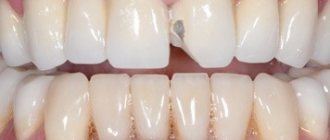During pregnancy, the expectant mother should take care not only of herself, but also of the child, because the health of the child’s teeth can be influenced even before birth.
While waiting for the baby, the expectant mother should eat a balanced diet in order to receive a sufficient amount of vitamins and microelements, and after the birth of the child, breastfeed.
It strengthens the baby's immunity and helps to develop properly. But what to do if, after the appearance of the first teeth, you notice that the enamel on children’s teeth has begun to wear off? The structure of tooth enamel contains calcium hydroxyapatite. Children have a certain supply of calcium from birth, but if it is not enough, the tooth enamel begins to deteriorate.
Tooth wear in children: causes
A child’s teeth wear out for the following reasons:
- congenital abnormal bite;
- bruxism (the child often grinds his teeth in his sleep);
- sensitive and fragile tooth enamel due to certain diseases (hypoplasia, etc.);
- genetic predisposition.
Strong abrasion of tooth enamel is caused by straight and deep bites, leading to accelerated exposure of dentin. One of the reasons for the appearance of malocclusion is disturbances in the development of the jaws, which increases the load on the teeth.
A child’s teeth can also wear out due to systemic diseases that reduce the resistance of body tissues: endocrine disorders, diseases of the central nervous system, etc.
Tooth wear can go through several stages.
How can you tell if the enamel is wearing off?
First, the top layer of enamel is affected - the tissue becomes more faded, and the bottom of the erosive lesion looks hard and smooth. A person experiences discomfort while eating due to increased tooth sensitivity. When eating too hot, cold or sweet food.
Many people mistakenly assume that worn enamel is a cosmetic problem. However, if the tissue surface is not restored in time, the enamel will continue to deteriorate, the damage will affect the dentin, and then the tooth pulp.
How to restore worn enamel?
What to do if the enamel on your teeth is worn away? Firstly, don’t worry - in the vast majority of cases, the tissue can be restored. And, if you recognize weakening teeth at an early stage, you can restore them to their former strength even at home.
In later stages of enamel destruction, you must consult a dentist. The doctor can perform one of the restorative procedures:
- Fluoridation of enamel
helps increase the resistance of teeth to aggressive substances - fruit acids, soda, tobacco. This treatment procedure can be used at any stage of enamel wear. - Placing fillings
will help restore the thickness of the enamel and strengthen damaged areas of the tooth. - Installation of veneers.
The thinnest plates installed on the teeth strengthen the enamel, replace the outer layer of crowns, and also correct the shape and color of the row. - Remineralization
or application of substances with calcium, fluoride, and vitamins to the teeth. The composition is absorbed almost instantly, covers damage and gradually strengthens the enamel.
If you notice that the enamel on your teeth has worn away in the initial stages of the disease, you can use home remedies to strengthen it. We have formulated several recommendations, following which you can restore the damaged layer.
- Be careful with products containing fluoride.
If you live in areas with high levels of fluoride in the water, you should never use fluoride toothpaste. Remember, excess fluoride is just as harmful as a deficiency of this element. - Eat right.
Do not forget that teeth need calcium, phosphorus, as well as vitamins D, A, K, C. Remember, dairy products, eggs, and raw vegetables and fruits are also useful for enamel. But it is better to avoid lemonade, alcoholic drinks and cigarettes to maintain dental health. - Include solid foods in your daily diet.
Carrots, apples, celery will help clean your teeth from food debris and perfectly strengthen the enamel. - Take good care of
your mouth and visit your dentist twice a year. - Massage your gums regularly.
With improved blood circulation, beneficial substances penetrate tissues faster and saturate them with vitamins. - Use natural remedies to strengthen enamel.
Tea tree solutions and herbal decoctions have proven themselves to be excellent. For thinned enamel, even rinsing with sea salt is helpful. To prepare a saline solution, simply dissolve 4 teaspoons of salt in half a glass of water. - Remember about folk remedies.
Even in Soviet times, activated carbon, lemon zest, and baking soda served as faithful assistants in the fight for strong, healthy teeth.
A useful product for enamel is green tea. Just one glass of this refreshing drink a day will help reduce your chances of losing teeth by 15-20% and strengthen your enamel.
Dentists recognize ASEPTA PLUS toothpaste Remineralization as one of the most effective means of strengthening worn enamel. This product is designed to strengthen weakened enamel and protect gums from inflammation. The paste contains hydroxyapatite, a source of natural bioactive calcium and phosphorus, thermal mud, the enzyme papain, which breaks down plaque, zinc and potassium, as well as extracts of Eleutherococcus and calendula, which accelerate the regeneration processes of the oral mucosa (a special case during pregnancy).
Degrees of tooth abrasion
- Stage I – the enamel of the cutting edges of the child’s incisors and canines and the upper part of the chewing cusps and molars is erased, the dentin is partially affected.
- Stage II – severe abrasion of the chewing tubercles with exposure of dentin tissue.
- Stage III – the height of the tooth crown is reduced to 2/3 of the normal size during wear.
- Stage IV – abrasion of the tooth to the level of the neck. The crown of the tooth is almost completely erased.
If 1 – 2 teeth of a child are worn out, then this is local abrasion; if several teeth or the entire dentition are affected, then this is generalized abrasion.
And then there’s aesthetics
Aesthetic procedures include those that do not affect the functions of teeth, but simply make them attractive. Let's take a closer look at what you can do to improve the appearance of your teeth.
Artistic restoration
This includes masking small cracks, chips, and scratches in the enamel with filling material, if the tooth root is not damaged. Artistic restoration, or, as it is sometimes called, “extension,” is a good way to hide small defects for those who are satisfied with the natural color of the enamel. The color of the aesthetic filling is matched to the color of the remaining teeth, the filling looks natural. But it will no longer be possible to bleach it, so after such a restoration, bleaching is not recommended - the natural enamel will become lighter, and the filling may begin to stand out.
Whitening
If you like the shape of your teeth, there is no fluorosis or other stains on the enamel, but you want to lighten it, whitening is ideal. In a clinical setting, it is completely safe, since all drugs are certified, have been used for a long time and are well studied.
Whitening has virtually no risks; it is a simple and harmless procedure.
Installation of veneers
If the teeth are healthy, the bite is correct, but the patient does not like the natural shape of the teeth (for example, they are too small) or there are noticeable defects in the enamel, then installing veneers will be the solution.
The modern trend in installing veneers is a white, but natural shade and imitation of the texture of natural enamel, so that the teeth do not look “made.”
Veneers that are too white look unnatural
The size of the veneers is selected taking into account the individual characteristics of the patient’s appearance. By selecting the thickness of the plates, you can adjust the shape of the lips (veneers on the front incisors slightly raise the lips, but here it is important to observe the measure, otherwise the result will not be natural), and with the help of the form - the gum line.
There are generally accepted standards for the shape and proportions of veneers, but in each case the doctor selects them individually.
You can literally install from one piece, if this is justified, in order to hide some shortcomings. But the best results are obtained when veneers are installed over the entire smile area (10–12 teeth on top and the same number on the bottom).
Veneers are the best way to hide all dental imperfections
Consistently using all these technologies, anyone can get a perfect smile, regardless of the initial data.
Pathological abrasion: consequences
Pathological abrasion – rapid reduction of enamel and dentin, teeth become shorter, sensitivity increases. How to understand that tooth wear has become pathological, and what could be the consequences?
- The surface of the child’s teeth becomes distorted and destroyed, and the edges of the tooth enamel become sharp. This can injure the tongue, as well as the delicate mucous membrane of the cheeks and lips.
- The height of the teeth changes (if the disease progresses), which leads to malocclusion and deformation of the lower part of the child’s face.
- The position of the temporomandibular joint may change, and this can injure the jaw.
- The sensitivity of tooth enamel increases.
First of all, treatment, not aesthetics
If you are not satisfied with the appearance of your teeth, any changes should begin with a visit to a dental therapist, not an esthetician. While there are functional problems, it is impossible to move on to those procedures that only improve the appearance of teeth.
Therefore, if the teeth are uneven, orthodontic treatment is the first step. Aligners are the most modern way to correct a bite, because they are comfortable and unnoticeable. With them, treatment is not only quick, but also psychologically simple for the patient: there is no need to get used to new restrictions, brushing teeth with the help of special devices, or even the appearance of the structure.
There are no age restrictions for wearing aligners: they can be worn by children from the moment a permanent bite has formed, by teenagers and by adults.
If individual teeth are missing, there are two options:
- In some cases, you can close the gap between adjacent teeth with the help of aligners, form an even and dense row of teeth and do nothing else. If a chewing tooth (5–7th) was missing, then visually it will not be noticeable. But functionally this method is not the best, since the symmetry of the dentition may be disrupted. In addition, this way you can hide the absence of at least one tooth.
- Prepare the site for implantation using orthodontic treatment. Then carry out implantation. The method takes longer, but the result is complete restoration of the functionality of the teeth.
The place for the implant is prepared while wearing aligners.
The treatment procedure is exactly this: first, the bite is corrected, then the implants are installed. Once the implant is installed, the teeth should no longer move. Implants are designed to be installed with correct bite (closure). If the teeth close together in such a way that the load during chewing is distributed unevenly, then the implant will either receive less load or receive excessive load. Both are unacceptable. Any experienced doctor will refuse to place an implant if there is a malocclusion, as he will not be able to provide a guarantee for his work.
First - to the orthodontist, then, if necessary - to the implantologist.
What to do if your child's teeth are worn out
Treatment for tooth wear is developed individually. At the appointment, the pediatric dentist analyzes the causes of the pathology, determines the stage of erasure, the nature of the disease and the characteristics of the development of the child’s body.
Restoration of worn teeth
Restorative treatment is carried out while preserving at least half of the hard tissues of the tooth. The technique takes place in several stages:
- Preparation. Necessary to identify the causes of diseases and their elimination or minimization, as well as the protection of remaining teeth. During preparation, an occlusal splint is made and installed if the patient suffers from bruxism. If necessary, the doctor prescribes consultations with various specialists, explains the rules of oral hygiene, and sanitizes foci of infection.
- Evaluation of the preparatory stage. After some time, the patient comes for an appointment, and the doctor assesses the condition of the teeth, checks whether the patient followed all the recommendations correctly, and discusses the upcoming treatment with him.
- Restoration. It is carried out in a certain order. First, the teeth are prepared, then the teeth on the upper jaw are restored, and only then on the lower jaw. Using a table of anthropometric data for each tooth, the doctor gives the patient's new teeth a certain length and shape.
- Observation. After successful treatment, the doctor observes the result for some time. In the first year, the patient should come for an appointment once a month, then less and less, but not less than once every 12 months. If any defects are identified, they are repaired or other treatment methods are applied.
This type of treatment, like any other, requires the patient to strictly adhere to all recommendations, give up bad habits, eat right, regular examinations by a specialist, and carefully observe hygiene skills.
Do you want beautiful dental restoration?
8
or order a free call
Request a call
How the shades of cement were selected during fixation
The work on dental restoration was varied, and we worked with both crowns and dental modules:
- the upper anterior teeth, which were restored using “crown + tooth root” modules, were fixed with double-curing cement,
- and those teeth on which I placed veneers and crowns were fixed with light-curing cement so that in bright daylight the glue would not be noticeable
Light reflecting off the crown or veneers can make the luting cement visible. In addition, due to the fact that the working surfaces of the teeth were of a non-uniform color, with the presence of a yellow tint, it was necessary to work with different colors of cement. That is, I used more yellow cement where the roots of the teeth were and used light-neutral-colored cement on the veneers and crowns to achieve a uniform color scheme. It's very difficult to get the color perfect
.
But we managed to do
:
Naturally, Aryuna is now the most super beautiful:
Aryuna, as I said earlier, works on television, she is a fairly public person - she interviews TV and show business stars. She appears on camera very often, and for her such a smile is not only a guarantee of her good mood, but also great confidence in herself and her abilities. After all, an open and cool smile is the key to female success
! This job, according to her, is the ideal solution for her. Made your smile easy, quick and beautiful!
Aryuna left a video review, short but very charming
:
And in conclusion of my story about this case of restoration of the front teeth, let’s once again go through all the stages
of transforming Aryuna’s smile:
- Photo BEFORE the start of
dental restoration. Aryuna came to me with such a smile; she has old temporary structures. - View of temporary structures on the 6 anterior teeth of the upper jaw.
- Temporary structures were removed and teeth and tooth roots were prepared for prosthetics.
- Selecting the color of the veneers.
- New temporary structures were installed. Your smile transformation has begun!
- Aryuna's smile with new temporary structures.
- In the meantime, we prepared the permanent teeth. This is how they “sit” on the model.
- And this is what all the elements of the teeth that we will install for our patient look like
- The teeth have been installed. Close-up - looks great!
- View of a smile on the right
- View of a smile from the left
- FINISH!
ARYUNA'S SMILE WITH NEW TEETH!
Author:
Sergey Samsakov
orthopedic dentist
born 02/02/1989
Education:
2011 — Graduated from the Moscow State Medical and Dental University named after. A.I.Evdokimova
2012 — Internship in the specialty “Orthopedic Dentistry”, Moscow State Medical University named after. A.I.Evdokimova
2014 - Residency in Orthopedic Dentistry, Moscow State Medical University named after. A.I.Evdokimova
What to do after a blow
Dental bruises are closed injuries received after strong mechanical impact. (hitting a hard object). In this case, the teeth remain in place, do not move, but may begin to move. The front ones are especially vulnerable. If your front tooth becomes loose after an impact, you should immediately consult a doctor so that you can save it. X-rays and electroodontodiagnosis are prescribed. The latest diagnostic method makes it possible to see the beginning of the development of tissue necrosis and remove dying particles to prevent inflammation.
As a rule, medications are not used for tooth bruises. Swelling of the gums is relieved with cold compresses, and the patient must be on a liquid diet for some time to keep the molar at maximum rest. Sometimes, dentists practice grinding the cutting edge of the tooth and the cusps of the opposite tooth on the lower jaw, which the patient touches when chewing food.
If there is nothing left of the tooth
It happens that people put off visiting a doctor for so long that only emptiness remains in place of the crumbling unit. If the roots are preserved, a crown can be installed. If they are absent or are in an unsatisfactory condition for prosthetics, the patient is offered implantation. This is a dental operation during which a titanium pin is implanted into the jaw bone. After its healing, an abutment and an artificial crown are installed on top.
If the client refuses implantation, a dental bridge can be installed. But then you will have to depulp and file the healthy teeth located on both sides of the empty space.
Treat crumbling teeth on time, then you won’t have to spend a lot of time, money and effort on restoring them. At the first symptoms of a destructive process, contact your dentist.
Crown as a way out
Pathological tooth wear can be eliminated with the help of crowns. They can be installed both on the front teeth and on the chewing teeth and restore the aesthetics and functionality of the oral cavity. Crowns can be made from various materials, each of which has its own advantages and disadvantages:
| Material | pros | Minuses |
| Metal ceramics | Durability, high aesthetic qualities, not the highest price | Depulpation of the tooth and grinding of a large amount of hard tissue are required. |
| Metal-free ceramics | The best aesthetics that are not lost over time, high strength, durability. | High price. |
| Metal | High strength, durability, low cost. | Lack of aesthetic qualities. |
When choosing a certain material, the patient must understand that he will need to replace a large number of crowns (perhaps even all). Therefore, it is worth giving preference to those materials that have good aesthetic qualities and a long service life.
After all the nuances of prosthetics have been agreed upon, we proceed directly to the procedure itself. At the first stage, the oral cavity is sanitized and teeth are prepared for crowns. Next, the doctor takes impressions of the jaws, based on which the dental technician makes a prosthesis. These operations may take some time, so the patient may be offered temporary plastic crowns. They will protect prepared teeth from the aggressive environment of the oral cavity and help adapt to new teeth. After the final version of the prosthesis is ready, it is tried on again and fixed with permanent cement.
How was the restoration of the front teeth carried out?
So, Aryuna had problem 4 front teeth; crowns and missing modules needed to be made on them:
- two missing modules with tooth roots,
- two crowns.
And we also decided to use the two upper canines
— put two Luxury veneers on them to make Aryuna’s smile more complete. Why did you decide to use fangs? – The canines had to be included in the group for restoring the aesthetics of a smile, because the 4 restored teeth will eventually, after 5 years, be noticeable in color - their own teeth will darken, but the veneers will not.
We ended up working with six teeth
.
Stages of smile restoration:
My first task
temporary crowns were removed and four teeth were prepared: two for a crown and two for monolithic crown + tooth root structures:
Second task
I had to minimally prepare the two upper canines for veneers, which I did.
I treated the fangs with micro-grinding. I also made six temporary structures in the first appointment. smile
immediately :
We removed the old temporary crowns, ground the teeth and made new temporary orthopedic structures, and after 4 days we received laboratory veneers: the color of the neck is 1M2, and the body of the tooth is 1M1:
At the second appointment, I removed the temporary structures, installed all six new teeth for fitting, and the patient really liked everything. And after that I recorded them permanently.
Sergey Samsakov
